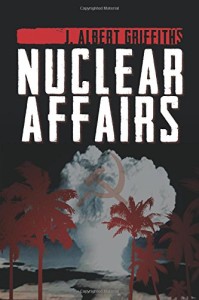
We follow the stories of several lives caught up in the numerous changes in the national, international, and American household status quo, including young recruits, aging veterans, housewives, and secret agents, and stumble upon a conspiracy that could heat up the Cold War to nuclear temperatures.
Griffiths tells on the reverse cover of the book that years of lived experiences and research culminated in the story within, and it’s clear to see that these claims aren’t empty. The general tone aside – which is, viscerally, mostly on-point for the time period – the book draws on many details both in setting and in military history that are clearly drawn from familiarity. The main focus of the novel is, in fact, based on several real, lesser-explored elements of Cold War history, despite the many fabrications that make up the plot. This story of a hanging thread maintained by the many unsung heroes and shadowy villains of the conflict is, at its core, compelling and uniquely interesting for this kind of historical military fiction, well worth the words to tell it.
Concurrently, the plot itself is stretched out greatly between the many point-of-view characters we’re given on-and-off, padded out with extraneous threads that often fail to deliver anywhere near as much satisfaction as any advancement on the nail-biting Sword of Damacles. It’s clear that these characters are meant to add to the stakes of the situation by bringing personality into circumstances, but remain slightly saccharine and artificial, despite everything, and are a distracting amount of fluff.
The cast is however reasonably developed, if only in regards to the male members; sadly, the female characters are often thoroughly two-dimensional in most areas, given certain amounts of genuine character while being largely demoted to the roles of “love interest,” to the point of seeming sexually manic at times when the story deems an erotic moment necessary. There are definitely some exceptions, and this could be, to a degree, dismissed as “period appropriate.”
Less appropriate are the largely stereotyped foreign cast, including a Japanese sergeant who meets his explicitly vodka-craving Soviet contact in a traditional tea shop in the very first chapter, both speaking lightly-tilted English scattered with native phrases like “hai” and “nyet.” This seems to almost bolster the distinctly mid-century American flavor of the read, though not in the best of ways. This comes as surprising in the otherwise fairly realistic, researched, and very palpable descriptions and locations that show Griffiths as a more-than-competent writer for the genre.
The book is edited decently with a very appropriate cover to complete the package, new to the current edition and very welcome. Nuclear Affairs, for its faults, is gripping and unique, though overly long at times, suited best to anyone interested in the topic or period.
Review Overview
Design
Content
Editing
Get an Editorial Review | Get Amazon Sales & Reviews | Get Edited | Get Beta Readers | Enter the SPR Book Awards | Other Marketing Services























Leave A Comment